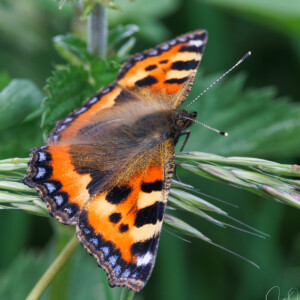Clean
I really didn't want to, but it had to be done, so I made another trip to Ripple today, in search of Common Clubtails. I trudged grumpily down to the dragonfly pond, around North Lake, up to the river, along the bank and up and down the more accessible of the fishing pegs, then finally around the fishing pool, before returning to the car and diving into a large flask-mug of coffee.
This, as you will no doubt have observed, is not that well-known misnomer the Common Clubtail, which may be common on the Continent, but is one of the UK's scarcest - and tricksiest - species. Rather, it's that other, increasingly ridiculous misnomer, the Scarce Chaser, which on the evidence of my records for the season so far should be renamed the Commonest Chaser in the County. Even though I've already posted several Scarce Chasers recently, I've chosen this image, which I captured in the furthest corner of the fishing pool, because it's simple and clean, and that rather graphic quality appeals to me. In odonatological terms, the interesting thing about it is that this male is fully mature - even the orange veining in his wings has disappeared, leaving just a hint of yellow staining around the permanent black patches at his wing bases - and yet, he's in perfect condition, with unblemished wings, and none of the tell-tale scratches on the sides of his abdomen that evidence sexual activity. I can't explain this, but it's noteworthy because Scarce Chasers are generally both precocious and voracious when it comes to copulation. However, it works for me photographically, so I'm not complaining.
I'm adding a second photo this evening, which also doesn't show a Common Clubtail. But Small Tortoiseshells have been declining in recent years, and this is now a species of conservation concern, so it was a pleasure to see several fresh specimens on the river bank today.
By now you won't really need me to spell out the fact that once again I didn't find a Common Clubtail - but I did get the next best thing. The fishing pegs along the river bank haven't yet been cleared in preparation for the coarse fishing season, and I wasn't prepared to risk the steps where they were heavily encrusted with dried mud, for fear of missing my footing, so I only checked a few of them. But on the second of these I found an exuvia, clinging to the edge of the platform where a dragonfly nymph had eclosed after climbing up one of the supporting piles. I'm not too skilled at identifying exuviae, but from the general shape, and the fact that it belonged to a riverine species, I knew it had to be either a Clubtail or a Scarce Chaser. So I carefully laid my equipment on the muddy debris on the platform, then knelt down, leaned over the edge, and coaxed the exuvia gently into a bug pot. There was a fierce wind blowing along the river, so I didn't dare take it out again to try to identify it, for fear of seeing it disappear into the water. But once I got home and was able to check it against my books, Obsidentify, and a reference specimen I already have, I got my answer: it's a Common Clubtail. To be honest, I'd have been almost as pleased with a Scarce Chaser exuvia, because I don't have one of those in my collection, but the fact that I can now record a Clubtail lets me put this season's search on the back burner, and move on to easier and more rewarding species.


Comments
Sign in or get an account to comment.


